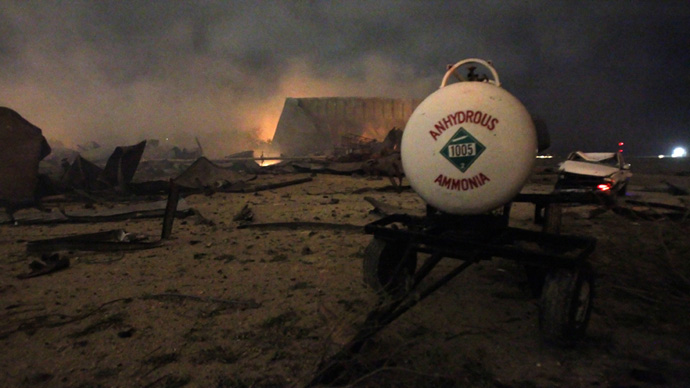Blast plant fined for lack of risk management plan, claimed ‘no fire danger’

The West Fertilizer Co factory of Texas, which exploded late Wednesday, was fined in 2006 by the Environmental Protection Agency for not having a risk-management plan. The same year the plant reported it posed ‘no risk’ of fire.
Complaints were made in June 2006 regarding a strong smell of
ammonia emanating from the plant, according to reports publicized
by The Dallas Morning News (DMN).
The concerns prompted Texas Commission on Environmental Quality to
investigate. The plant was fined later in August by the EPA, which
imposed a fine of $2,300 for failure to have a risk-management plan
that was in line with federal standards.
Such federal regulations are in place to ensure the prevention of
chemical accidents through safeguards.
A later report filed by the plant itself with EPA stated
“no” under fire or explosive risks, saying that the,
“worst possible scenario … would be a 10-minute release of
ammonia gas that would injure no one.”
They went on to say that their ‘second-worst’ scenario would be a
leak from a broken hose used to transfer the product, which would
also not result in any injuries.
The facility stated that it had no other dangerous chemicals on
hand, adding that the plan was on file with the local fire
department and that the company adhered to proper safety rules.
Anhydrous ammonia is liable to explode if kept in certain
concentrations inside containers. However, it is not generally
considered a risk when in the air and in gas form.
Regulators in Texas were fully aware that the fertilizer plant
harbored two 12,000-gallon tanks of anhydrous ammonia and was near
a school and residential neighborhood.

Occupational Safety and Health Administration (OSHA) online
records also show that there have been no federal inspections of
West Fertilizer Co. over the past five years.
The OSHA itself has repeatedly come under fire for being “dangerously
ineffective” in protecting the health and safety of workers
across the US.
“The regional investigator described the area surrounding the facility as residential and farmland. There are two schools located within 3,000 ft. [1km] of this facility,” said the DMN report.
A middle school, a nursing home and a hospital were all within a 1,500 feet radius of the plant when the explosion occurred, killing up to 15 people and injuring some 160 others.
The West Fertilizer Co. itself reported having as much as 54,000lbs (24.5 tonnes) of anhydrous ammonia on site.
“It’s revealing some of the weaknesses of the US state and its
regulatory architecture,” Professor Sreeram Chaula, a world
affairs analyst, told RT.
“What has happened in Texas is symptomatic of the larger issue of world economy – we have lost any moorings in terms of how to regulate and manage capitalist industries,” he said.














